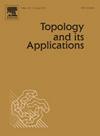On the preservation of topological properties under group multiplication in topological groups
IF 0.6
4区 数学
Q3 MATHEMATICS
引用次数: 0
Abstract
The Lindelöf property, cellularity, countable compactness, countable pracompactness, and pseudocompactness are not finitely productive properties. Multiplying subsets of a topological group does not preserve these properties either.
We continue the study started by A.V. Arhangel'skii a few years ago and show that if U is an open Lindelöf (countably cellular, or countably compact) subset of a topological group G and a subset F of G is Lindelöf (countably cellular, countably compact or countably pracompact), then the group products UF and FU are also Lindelöf (countably cellular, countably compact or countably pracompact) subspaces of G. Therefore, the open subgroup of G algebraically generated by is Lindelöf (countably cellular, or is the union of a countable family of open countably compact or countably pracompact subsets). Similarly, if U is an open pseudocompact subset of G and a set is pseudocompact, then the group products UF and FU are pseudocompact subspaces of G.
It is also established that if B and C are bounded subsets of a locally feebly compact paratopological group G, then the sets , and BC are bounded in G. Hence, every bounded subset of G is contained in an open σ-bounded subgroup of G.
论拓扑群中群乘法下拓扑性质的保持
Lindelöf性质、细胞性、可数紧性、可数实紧性和伪紧性不是有限生产性质。将拓扑群的子集相乘也不会保留这些属性。我们继续几年前由A.V. Arhangel'skii开始的研究,并证明如果U是拓扑群G的开放Lindelöf(可数元胞或可数紧)子集,并且G的子集F是Lindelöf(可数元胞,可数紧或可数紧),则群积UF和FU也是G的Lindelöf(可数元胞,可数紧或可数紧)子空间。由U∪F代数生成的G的开放子群为Lindelöf(可数元胞,或可数族开放可数紧子集或可数实紧子集的并)。同样,若U是G的开拟紧子集,且集合F≥G为拟紧,则群积UF、FU为G的拟紧子空间。还建立了若B、C为局部弱紧准拓扑群G的有界子集,则集合B−1、C−1、BC在G中有界,因此,G的每一个有界子集都包含在G的开σ≤有界子群中。
本文章由计算机程序翻译,如有差异,请以英文原文为准。
求助全文
约1分钟内获得全文
求助全文
来源期刊
CiteScore
1.20
自引率
33.30%
发文量
251
审稿时长
6 months
期刊介绍:
Topology and its Applications is primarily concerned with publishing original research papers of moderate length. However, a limited number of carefully selected survey or expository papers are also included. The mathematical focus of the journal is that suggested by the title: Research in Topology. It is felt that it is inadvisable to attempt a definitive description of topology as understood for this journal. Certainly the subject includes the algebraic, general, geometric, and set-theoretic facets of topology as well as areas of interactions between topology and other mathematical disciplines, e.g. topological algebra, topological dynamics, functional analysis, category theory. Since the roles of various aspects of topology continue to change, the non-specific delineation of topics serves to reflect the current state of research in topology.
At regular intervals, the journal publishes a section entitled Open Problems in Topology, edited by J. van Mill and G.M. Reed. This is a status report on the 1100 problems listed in the book of the same name published by North-Holland in 1990, edited by van Mill and Reed.

 求助内容:
求助内容: 应助结果提醒方式:
应助结果提醒方式:


